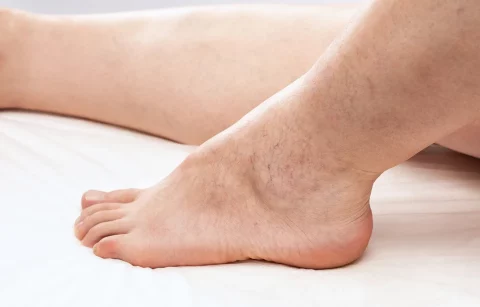Spider Veins in Men: Breaking the Stigma, Understanding the Facts
Many people associate spider veins with women, but they can affect men as well. These small, discolored veins near the skin’s surface can be a cosmetic concern and sometimes cause discomfort. Understanding the causes, symptoms, and treatment options for spider veins can help men manage this issue effectively.
What Are Spider Veins?

Spider veins (also known as telangiectasias) are small, dilated blood vessels visible just under the skin’s surface. They typically appear red, blue, or purple, and often resemble tree branches or spider webs. While they occur most often on legs and face, they can develop anywhere on the body.
Are Spider Veins Common in Men?
Yes, while more commonly associated with women, a sizable population of men experience spider veins too. About 40-45% of men suffer from spider veins at some point in their lives.
Causes of Spider Veins in Men
Here are some key factors contributing to spider veins in men:
- Genetics: A predisposition to spider veins can be inherited.
- Age: The risk increases with age due to the weakening of vein walls and valves.
- Prolonged standing or sitting: Professions that require extended standing or sitting put extra pressure on leg veins, hindering efficient blood flow.
- Weight: Obesity puts excess strain on the veins, raising the risk of spider veins.
- Hormonal changes: Hormonal shifts can influence the health of vein walls.
- Sun exposure: UV rays can weaken and damage blood vessels close to the skin’s surface.
- Injury: Trauma or injury to a particular area can lead to the development of spider veins.
Symptoms: Signs to Watch For
While usually painless, spider veins are mainly a cosmetic issue. However, they can occasionally cause discomfort. Some men might experience:
- Aching or discomfort:
- Type of pain: Men may feel a dull ache, heaviness, or a mild burning sensation in the legs or the area affected by spider veins.
- When it worsens: Prolonged standing, sitting, or physical activity can intensify these sensations due to increased pressure on the veins.
- Swelling:
- Common area: Swelling usually occurs in the legs and ankles, especially towards the end of the day.
- Underlying reason: Faulty valves in the veins cause blood to pool rather than flow back to the heart, leading to fluid buildup, which causes swelling.
- Itching:
- Affected location: Men may feel the itchiness directly around the visible spider veins.
- Possible reasons: Sometimes the skin over spider veins can become dry or irritated, causing itching.
When Should You Be Concerned?
Although usually harmless, it’s important to consult a doctor if you notice:
- Sudden onset of swelling, redness, or warmth in the area, which could point to a blood clot.
- Ulcers or sores near the spider veins.
- Signs of bleeding.
- Spider veins that are very painful and cause significant discomfort.
Common Treatments for Spider Veins

If spider veins are a cosmetic bother or cause discomfort, there are several treatment options:
- Compression stockings: Graduated compression stockings can help improve blood flow, reducing the appearance of spider veins and alleviating discomfort.
- Sclerotherapy: This involves injecting a solution into the spider veins, causing them to collapse and eventually get absorbed by the body.
- Endovenous Laser Treatment (EVLT): This minimally invasive procedure is used for larger varicose veins that may be contributing to spider veins. It involves inserting a laser fiber into the damaged vein to deliver heat and close it off.
- Surface laser and intense pulsed light (IPL) treatments: Like traditional laser treatment, these options use light energy to target and destroy spider veins. These are typically better suited for smaller spider veins near the skin’s surface.
- Vein Surgery: In very rare cases, surgery may be necessary to remove large varicose veins. These procedures usually involve tying off the vein (ligation) or removing it entirely (stripping).
How To Prevent Spider Veins
Here’s how men can reduce the risk of developing spider veins:
- Maintain a healthy weight: Losing excess weight reduces strain on the veins.
- Exercise regularly: Activities like walking and jogging promote good circulation.
- Reduce prolonged sitting or standing: Take breaks to stretch and move around. If your job requires extended standing or sitting, elevate your legs periodically when possible.
- Protect skin from the sun: Wear sunscreen when outdoors.
- Manage underlying health conditions: Treat any underlying issues like high blood pressure that could contribute to vein problems.
Your Questions Answered: Learn More About Spider Veins in Men
Can spider veins go away on their own?
Unfortunately, spider veins are unlikely to disappear without intervention. However, lifestyle changes and prevention tactics can slow their progression and development of new ones.
Are spider veins and varicose veins the same?
While related, they are different. Spider veins are the smaller, more superficial veins near the skin’s surface. Varicose veins are larger, bulging, and often twisted, resulting from more serious vein problems.
Does insurance cover spider vein treatment?
Coverage depends on your individual insurance plan. If spider veins are causing significant medical issues (pain, swelling), treatment may be partially covered. Procedures deemed purely cosmetic are usually not covered by insurance.
How long does spider vein treatment take?
The duration varies depending on the chosen method and severity of the issue. Compression stockings provide ongoing management. Sclerotherapy and laser treatments typically require multiple sessions for best results, while EVLT is often a single procedure.
Conclusion

Spider veins, while often perceived as a women’s issue, are prevalent in men too. Understanding the causes, symptoms, and preventative measures can go a long way in managing this condition.
If the appearance or discomfort of spider veins becomes a significant concern, seeking medical advice is the best course of action. A doctor or vein specialist will help determine the right treatment plan tailored to your individual needs.







